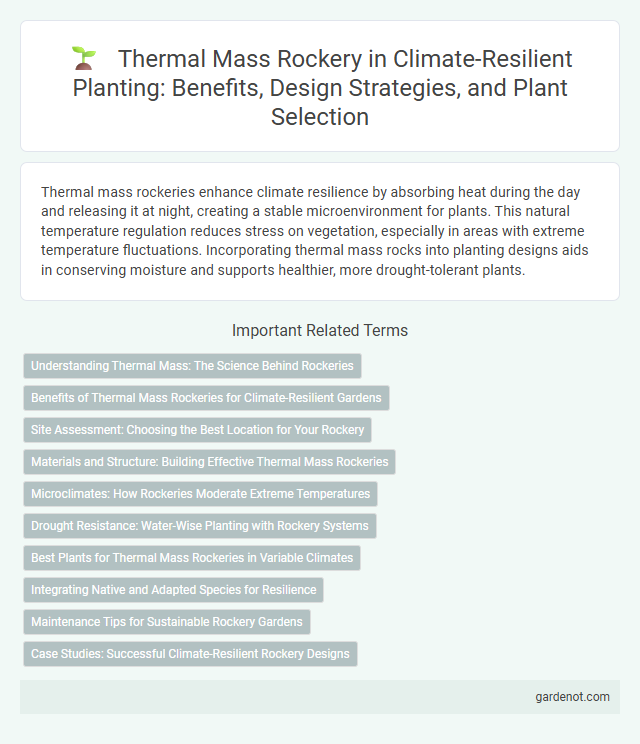Thermal mass rockeries enhance climate resilience by absorbing heat during the day and releasing it at night, creating a stable microenvironment for plants. This natural temperature regulation reduces stress on vegetation, especially in areas with extreme temperature fluctuations. Incorporating thermal mass rocks into planting designs aids in conserving moisture and supports healthier, more drought-tolerant plants.
Understanding Thermal Mass: The Science Behind Rockeries
Thermal mass rockeries utilize dense rocks that absorb, store, and gradually release heat to regulate microclimates in planting areas. This natural heat retention supports climate-resilient planting by minimizing temperature fluctuations and protecting plants from frost damage and heat stress. Understanding the thermal properties of various rock types enhances the effectiveness of rockeries in stabilizing soil temperature and promoting plant health.
Benefits of Thermal Mass Rockeries for Climate-Resilient Gardens
Thermal mass rockeries absorb and store heat during the day, releasing it slowly at night, which stabilizes soil temperature and extends the growing season in climate-resilient gardens. This temperature regulation reduces plant stress from extreme temperature fluctuations and supports the survival of drought-tolerant species. Furthermore, rockeries improve water retention and reduce evaporation, enhancing garden resilience in arid and variable climates.
Site Assessment: Choosing the Best Location for Your Rockery
Site assessment for a thermal mass rockery involves analyzing sun exposure, soil type, and drainage to maximize heat retention and plant resilience. Positioning the rockery on a south-facing slope or areas with full sun enhances thermal absorption, benefiting cold-sensitive plants. Evaluating wind patterns and avoiding frost pockets ensures microclimate stability, promoting a thriving climate-resilient garden.
Materials and Structure: Building Effective Thermal Mass Rockeries
Thermal mass rockeries utilize dense materials such as granite, basalt, and sandstone to absorb and slowly release heat, creating microclimates that support climate-resilient planting. The strategic layering and sizing of rocks enhance heat storage and moisture retention, allowing plants to thrive in varying temperatures. Incorporating porous stones and organic matter within the structure further improves thermal regulation and soil health, promoting sustainable growth in harsh climates.
Microclimates: How Rockeries Moderate Extreme Temperatures
Thermal mass rockeries create microclimates by absorbing and slowly releasing heat, which moderates extreme temperature fluctuations in surrounding areas. This thermal regulation protects sensitive plants from frost during cold nights and reduces heat stress during hot days, enhancing their resilience to climate variability. Rockeries also improve local humidity and wind patterns, further stabilizing the microclimate for optimal plant growth in challenging environments.
Drought Resistance: Water-Wise Planting with Rockery Systems
Thermal mass rockeries enhance drought resistance by storing heat during the day and releasing it at night, creating a microclimate that supports water-wise planting. Rockery systems reduce soil evaporation and retain moisture, making them ideal for drought-prone environments. Integrating native, drought-tolerant plants with rockeries optimizes water efficiency and promotes sustainable landscaping under changing climate conditions.
Best Plants for Thermal Mass Rockeries in Variable Climates
Best plants for thermal mass rockeries in variable climates include drought-tolerant succulents such as sedum and echeveria, which thrive in heat-retentive environments. Lavender and thyme also perform well due to their ability to withstand fluctuating temperatures while adding fragrance and texture. Incorporating native grasses like blue fescue enhances soil stabilization and adapts to both cold and warm seasonal changes effectively.
Integrating Native and Adapted Species for Resilience
Thermal mass rockeries create microclimates that buffer temperature extremes, enhancing the survival of native and adapted plant species. Incorporating drought-tolerant and heat-resistant flora native to the region supports biodiversity and reduces water consumption. This integration promotes climate resilience by stabilizing soil moisture and providing habitat connectivity in changing environmental conditions.
Maintenance Tips for Sustainable Rockery Gardens
Thermal mass rockeries retain heat efficiently, reducing temperature fluctuations and supporting climate-resilient planting. Regularly removing debris and dead plant material prevents moisture buildup and fungal growth, ensuring soil health. Applying organic mulch and checking drainage systems minimize erosion and sustain moisture levels for long-term garden resilience.
Case Studies: Successful Climate-Resilient Rockery Designs
Thermal mass rockery designs effectively regulate soil temperature and moisture, enhancing plant survival in extreme climates. Case studies from arid regions in Australia and Mediterranean gardens demonstrate improved drought resistance and prolonged growing seasons through strategic rock placement and material selection. These successes highlight the role of thermal mass rockeries in sustainable landscaping and climate resilience.
Thermal mass rockery Infographic

 gardenot.com
gardenot.com